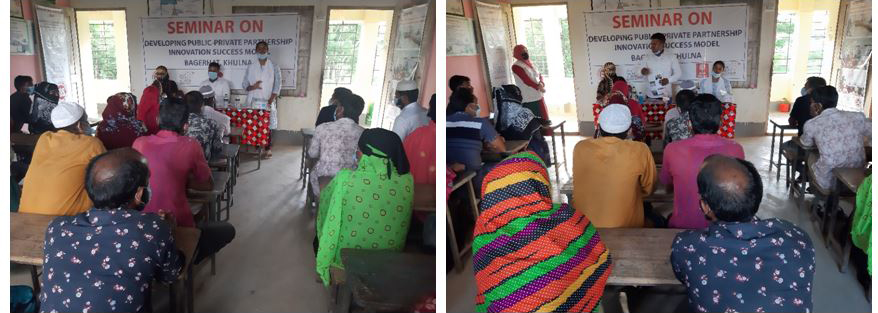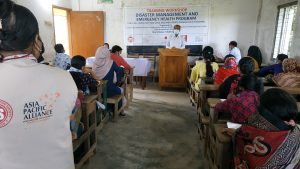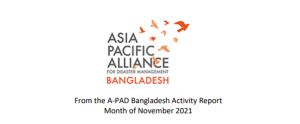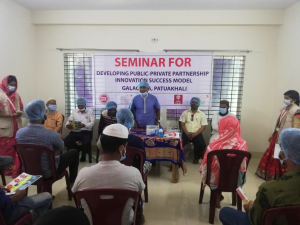
A-PAD Bangladesh Activity Report Month of September 2022
.
Project Title: Capacity Building Project for the Establishment and Sustainable Management of a Multi-Sector Platform for Disaster Management in Bangladesh
Project Period: 17 January, 2022 – 16 January, 2023 (12 month)
- Project Activities and Accomplishments
Bangladesh is one of the hazard prone countries in South Asia. Floods, droughts, landslides, thunderstorms, hurricanes and cyclones occur regularly. Among these earthquakes, floods and drought risk are extremely high. These hazards threaten millions of lives and cause large scale financial, infrastructure, agriculture and productivity losses that seriously hinder Bangladesh’s overall development. Bangladesh has limited resources and lack their own disaster management plans. Considering these problems, this paper attempts to throw light on a more integrated and responsive disaster management system in Bangladesh. Disaster Management approaches in Bangladesh harmonizing systematic inquiry of Disaster Management in Bangladesh is not well conversant in the available literature. Moreover, this approach taken from different programs at national, international and community level, which is not redeveloped, aligned with the field experiences and theoretical viewpoint.
A-PAD Bangladesh started project from January 2020 and presently continue it 17 January 2022 to build up capacity on disaster management. It communicate with the different sectors like local community, community leaders, stakeholders, GOVT. officials continuing training on disaster management. To hold training program A-PAD Bangladesh staff organized small community meeting to sharing ideas on disaster and introduced them about A-PAD Bangladesh activity. A-PAD Bangladesh working 7 divisions in last years.
There are 2 health workers in each divisions whose are doing home visit and aware the local community about basic disaster awareness. The health workers gave basic ideas about disaster management. A-PAD Bangladesh working at the rural areas. If there would be any directions or announcement from GOVT. or any disaster related news has been published the health workers delivered the message to the local community. Like Bangladesh GOVT. started vaccination program which many people did not know and some people did not interested about taking vaccine. So that the health worker visited different areas to give message about the vaccination program. Total 4,360persons were benefited from A-PAD Bangladesh on September 2022.
A-PAD Bangladesh attended coordination meeting at the 7 divisions in Office of Deputy Commissioner. At that meeting different NGOs had joined and explained their activities. Besides this what will be the next activities of the GOVT. and NGOs were discussed at that meeting.
1. To manage the emergency disaster management coordination centers in disaster-prone areas (Outcome 1) The disaster management coordination center in disaster vulnerable areas established in this project (3 year project) functions as a disaster response base in each region, and contributes for preventing the spread of health damage to local residents and community-led disaster risk reduction measures. | ||
Activities | Outcome Indicators to Measure Results: | Project Status: Achievements vs Outcome: If the activity is behind the schedule, please write the reason. |
1-1 Utilization of Emergency Disaster Management Co-ordination Center Beneficiaries: 10 persons x 25 days x 7 divisions x 12 months = 21,000 persons (Monthly Goal: 10 persons x 25 days x 7 divisions = 1,750 persons) | 【Indicators of Outcome】 1-1: The disaster management coordination center is used for coordination meetings among partner organizations and stakeholders in normal times. It will also serve as a base for health and public health guidance for localresidents. In an emergency, emergency health personnel provide health services.21,000 local residents (annual average) in the target district use the disaster response management center or receive health services. (Indicator: number of visitors, record of services provided)
1-2: Covid-19 testing lab will prevent the spread of Covid-19 infections by conducting tests. More than 9,000 Covid-19 tests will be performed and the spread of infection is reduced by dealing with residents with symptoms and those who have no symptoms but are infected nearby and are worried about infection. (Indicator: number of tests, report of test results)
| Total 3,350 people visited to the Disaster Management Coordination Center to discuss about disaster preparedness and health related issues. Dhaka: 580 Persons Cox’s Bazar: 420 Persons Pabna: 380Persons Bagerhat: 510 Persons Patuakhali: 440 Persons Habiganj: 530 Persons Rangpur: 490 Persons Total = 3,350Persons
|
1-2 COVID-19 awareness program in 7 divisional areas Beneficiaries:25 participants x 4 sessions x 7 divisions = 700 participants |
| |
1-3 Establish quality lab facilities to identify the COVID-19 cases Beneficiaries: 30 persons x 25 days x 12 months = 9,000 persons (Monthly Goal: 30 persons x 25 days = 750 persons) | A-PAD Bangladesh established PCR Lab for COVID-19 test. In Bangladesh number of COVID-19 patients has average in number. In September 2022 total 650 COVID-19 test has been done | |
2. To establish and strengthen the NPF Partner network (Outcome 2) A-PAD BGD, NPF for disaster reduction and disaster response through collaboration between multi-sectors, will be established and expanded, and the disaster prevention and disaster capacity of its member organizations will be strengthened. | ||
2-1 Self-assessment of networking member organization | 【Indicators of Outcome】 2-1 NPF partner organizations carry out self-assessment, and the resources of each organization are digitized. Self-assessment clarifies partner roles, responsibilities, abilities, and interests. (Indicator: List and data of resources owned by each organization)
2-2 The “Strategic Plan for Disaster Prevention, Disaster Preparation, Disaster Response, and Restoration in each district” discussed at the Strategic Meeting will be formulated, and a framework for disaster prevention cooperation will be established. (Indicator: Strategic Plan)
2-3 More than 5 organizations from new partnerships with NPF A-PAD BGD annually to expand the NPF network. (Indicator: number of new MOUs signed for 3 years)
2-4 Resources possessed by A-PAD BGD partner organizations are provided in emergency disaster response, and play the role of that organization in an emergency. (Indicator: Lists of resources such as supplies, people and donations provided by partner organizations fora three-year emergency disaster response) | Results of the Self-assessment Required document; – List of resources such as supplies, people and donations provided by partner organizations for a three-year emergency disaster response
|
2-2 Strategic Planning Network Meeting Participants:100 persons x 5 villages x 7 divisions = 3500 participants
| A-PAD Bangladesh conducted strategic planning network meeting in Patuakhali.
10-09-2022,Kachua, Total Participants 50 11-09-2022, Sutabaria, Total Participants 50 12-09-2022, Chiknikandi, Total Participants 50 13-09-2022, Madhya Dakua, Total Participants 50 14-09-2022, Hogolbunia, Total Participants 50 Patuakhali is a district town located on the southern bank of the Laukathi River in the division of Barisal in Bangladesh. Galachipa is situated on the bank of the Ramnabad in Patuakhali District. Galachipa Upazila has many rivers and canals. More or less almost every district of this country is affected by the disasters. Among these 64 districts, Patuakhali district is a more disaster-prone area. For geographic location and weather conditions, cyclones, tidal floods, erratic rainfall, cold wave, arsenic contamination, and tornado are common in this area. Community Initiative Society (CIS) in Collaboration with Asia Pacific Alliance (A-PAD) implementing a capacity-building project for the establishment and sustainable management of a multi-sector platform for disaster management in Bangladesh.CIS arranged a 5 days strategic planning network meeting in 5 villages of Galachipa with a total number of participants are 500. Participants from different organizations, Local Communities, Community Leaders, Local NGOs, Private Organizations, and Govt. Officials, Joined that meeting. The main focus of the training program was Buildup a platform for Emergency Response in case of Disaster in Patuakhali. Improve capacity for disaster response at the community level during and after the Disaster. Coastal area is the meeting point between land and sea. the coastal area includes parts of the land, both dry and submerged in water which is influenced by marine characteristics such as tides, sea breezes and saltwater infiltration. The majority of people who live in the coastal areas of Village are fishermen. The people of the coastal areas do not yet have a capable capacity, because management in the coastal areas has not been carried out optimally. To develop the right technology for fishermen in the coastal areas and for their betterment this training has objectives such as (i) safe and fresh water supply, (ii) disaster risk reduction, (iii) efficient coastal zone management, (iv) economic growth, (v) sustainable management of natural resources, (vi) improved livelihoods, (vii) environmental protection, (viii) public awareness-raising, and (ix) institutional capacity building. The nature of coastal area management aims to: 1) community independence by developing economic activities and strengthening the economic institutions of coastal communities; 2) the community can manage and utilize coastal and marine resources optimally, sustainably and in accordance with the rules of environmental sustainability. Achievement of the objectives above the main thing that must be done is to increase the capacity of people living in coastal areas. Management patterns that involve community participation or bottom up. For coastal communities capacity building there are 5 strategies to strengthen the capacity of coastal communities, namely 1) Development of alternative livelihoods; 2) Access to Capital; 3) Access to Technology; 4) Access to markets; 5) Development of collective action. Implementation of this strategy by paying attention to the needs of coastal communities, the potential of the community, the potential of the environment and can appreciate the wishes of the people in the coastal region. If the management of the coastal areas using the 5 strategies above, applied consistently with involving the people in the coastal area will have an impact on the welfare of the community. | |
2-3 Networking partners DRR Training Participants:25 persons x 2 org x 7 divisions x 2 times = 700 participants
|
| |
27-28 Increase NPF members and maintain partnership
| Number of new NPF member organization, number of new MOUs signed for 3 years
| |
27-29 International Symposium on DRR
Participants:200 persons | Questionaries about the symposium Required Document; Symposium Report | |
3. distriTo strengthen the local capacity for emergency response and disaster risk reduction (Outcome 3) The knowledge and abilities of human resources involved in disaster prevention and disaster response will be improved in disastervulnerable areas, contributing to the strengthening of disaster response capacity building of local communities. | ||
3-1 a) Workshop on Disaster Management and Emergency Health Program
Participants:50 persons x 7 divisions x 2 times = 700 persons | 【Indicator of Outcome】 3-1 a) Build a network of community leaders who can lead disaster response and emergency health response in all districts in Bangladesh. (Indicator: number of community leaders who can lead emergency response, list of community leaders for disaster response/emergency health in all 7 districts. (3 years))
b) Network of human resources with skills and know-how to health response in an emergency will be established in all districts in Bangladesh to provide health services to local residents in an emergency.(Indicator: data of 25 NGO health response personals who can respond in an emergency, cases of activities during an emergency disaster in all districts, and the number of residents provided with services (3 years))
3-2 Disaster information and emergency response records are accumulated as a disaster archive. In addition, the activities and results of this project of A-PAD BGD will be introduced at international symposiums, internationalorganizations, and domestic and foreign media. (Indicator: situation report at the time of disaster, number of activity reports posted on A-PAD BGD website, international symposium report, introductory article) | Three days training workshop sad been done in the 2 divisional areas Cox’s Bazar and Rangpurwhere 50 participants had joined.
10-12 September 2022, Rangpur, Total Participants 25 25-27September 2022, Cox’s Bazar, Total Participants 25
Bangladesh is a riverine country. Floods occur in different regions of Bangladesh with little rain. Similarly, the people of Rangpur urban area also face floods. Asadha and shravan are the two months of monsoon. Rangpur is currently considered a densely populated city. During the rainy season, when there is excessive rain, the rain water cannot flow through the streets of the city. As a result, rainwater gets stuck in the city roads. Shyamasundari canal is a famous place in Rangpur. Shamasundari canal flows through Rangpur city. The canal is the only outlet for water in the city which is not properly monitored, when it rains excessively, the rainwater gets trapped which cause water logging. Three days training program was held in Rangpur and total 25 persons from different organizations, community had joined the training workshop. A community-based approach in disaster management is necessary in the risk-reduction process because communities are the local experts and know not only their own risks and needs but also possess innate sills, capacities and knowledge to enhance the process. Communities need to lead response efforts simply because they are the first responders and have the advantage of time and location to make the essential difference in their communities. During the training, the module is considered as the most important element because it has the ability to give the greatest impact. The training program is designed to prepare people to help not only themselves, but also their families and neighbors by receiving training on disaster preparedness and response. An organization have to seeks recognize the need for employee training and skills development. What matters most is the conversion of technology through people into better organizational performance. This training is also able to enhance emergency communication and at the same time building effective disaster preparedness and response.
CIS conducted Workshop on Disaster Management & Emergency Health Program at Cox’s Bazar Sadar. 3 days training programs were held at Khurushkul Union, Cox’s Bazar Sadar. the workshop includes topics on recent disasters like storm, Dengue, Conjunctivitis and others relevant issues etc. it was focusing both disaster management and health sectors so that at the training workshop it was focused on ‘Dengue, Conjunctivitis and its side effect and affect. People who are recovering from ‘Dengue and Conjunctivitis what side effect they have been facing and what measures can be taken to get out from the situation. At the workshop, Emphasized on preparing and carrying out cross-sect oral guidelines for disaster response cooperation in consultation with communities to Improving Local Capacity to Adapt Safety Net Programs to Climate Change. The purpose of the workshop is to enhance and improve community resilience; to promote the uses of science and technology in addressing climate change and DRR issues; enhance and improve disaster displacement; strengthen Disaster Risk Management (DRM). The focus of the Workshop is to provide a platform for experience and idea sharing between participating organizations to assist in identifying gaps in DRR strategies implemented by each areas. It also allowed participants to share innovative ideas and effective approaches that will assist communities in reducing and managing disaster risk and displacement risk. Participants were also provided the opportunity to identify elements for potential inclusions in the development and revision of the DRR strategies and plans.
|
3-1 b) Local NGO Emergency Health providers training
Participants:25 pers/time x 7 divisions = 175 persons |
| |
3-2 Seminar for Developing public-private partnership innovation success models
Participants:50persons x 7divisions x 2times =700participant | A-PAD Bangladesh conducted public private partnership seminar at Habiganj and pabna. 50 participants had joined in each division.
26September 2022, Pabna, Total Participants 30 28September 2022, Bagerhat, Total Participants 30
Pabna district is one of the disaster- prone areas in Bangladesh and main disaster of floods, cyclone, thundering, uncontrolled rainfall and fires. CIS conducted seminar on public private partnership innovation success model in pabna on 26september 2022. Public private partnerships (PPP) play an important role in disaster management. 100 participants from different organization like ngo, private organization from pabnahad joined that seminar. As the participants were from different background and different profession so the seminar was organized on that perspective. In this Seminar Govt. official shared their plan on Disaster Management and said that people now are more practical regarding disaster Management. During disaster people try to keep them safe and also try to prepare for future events which can cause loss to human life. For building resilience disaster preparedness play an important role as Disaster will occurs we can’t stop them but if we prepared ourselves for them we can easily cope up with the situation and the loss will be less. In this seminar Syed MdMontazAliMaligasha union council Chairman Pabna shared his opinion and appreciated that CIS is working on Disaster Management and awareness with the local people and all classes people are getting involved with Disaster Management they are now more aware. He wished that more Organization should come forward for this issue. On feedback session they shared this kind of seminars are very helpful and this kind of seminar helps the community people, community leader, private sector, stakeholders to take actions on disaster risk management. Bagerhat is a district in South-western Bangladesh. It is a part of the Khulna Division. For geographic location and weather condition, cyclone, tidal flood, erratic rainfall, cold wave, arsenic contamination, and tornado are common in this area. The main focus on training workshop was on build up on capacity on emergency response during and after disaster. CIS conducted a training program on Seminar on Public Private Partnership Innovation Success Model inSharankhola, Bagerhat. its main objective is to Minimize human suffering and damage as much as possible. Because it is not possible for us prevent natural disaster, if we try sincerely and collectively, changing our habits may reduce its frequency. The training was conducted focusing on different topics. As the participants were from different background and different profession so the training module was organized on that perspective. In this seminar MdAslam Hossain (GSK Manager) shared his opinion that due to climate change Bangladesh is facing multiple disaster Bagerhat faces multiple natural and man-made disaster and to cope up with than the vulnerable community needs help. During that emergency time Govt. and Private sectors coordination can have an impact on risk reduction plan for disaster management. This network platform can minimize any kind of situation accordingly if the partners works together. In that seminar the participants share their opinion on Future planning for emergency disaster management. They shared their experiences and challenges of public private partnership for disaster management. Innovative and flexible methodologies were adopted in conducting the training. | |
3-3 Update website contents as E-resources for Disaster Management | https://apad-bd.org/flood-response-2022/ https://apad-bd.org/wp-content/uploads/2022/09/cis-flood-response-habiganj3.jpg | |
- Challenges
- Practice in collaborationwithA-PAD Bangladesh Network Partners
Please writegood practice in collaboration with partner organizations
- Any contributionFunds Received and Grants Applied / Planned and Implemented Projects by CIS including Emergency Response
Please write Projects name and its fund resources
- Relationship with Bangladesh Government and Japanese Embassy
Please write aboutMeeting with Government officials
Strategic Planning Network Meeting-Galachipa
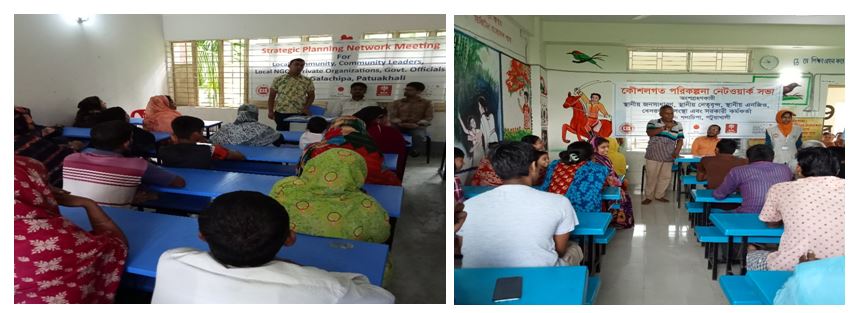
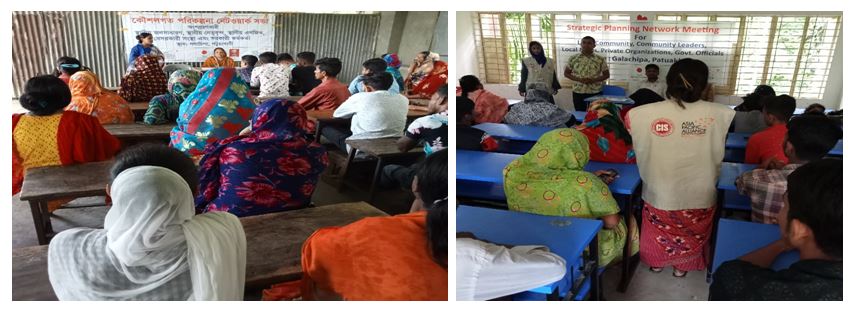
Workshop on Disaster management and Emergency Health Program-Cox’s Bazar

Public Private Partnership Seminar-Pabna
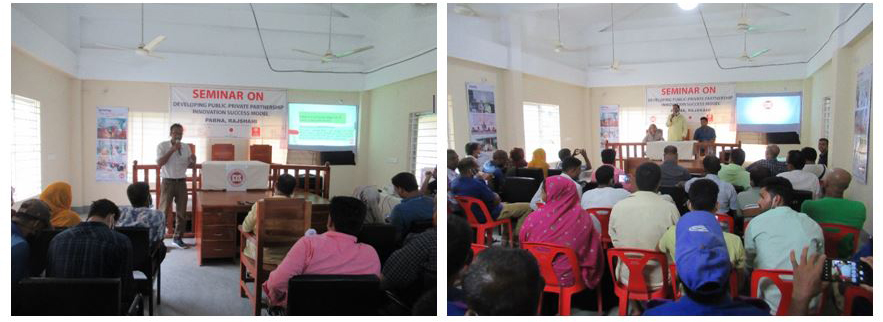
Public Private Partnership Seminar-Bagerhat
